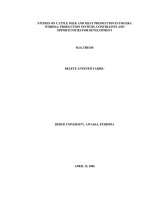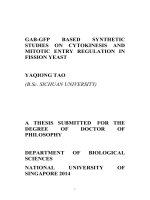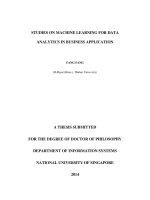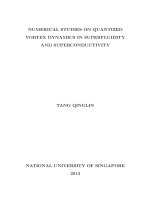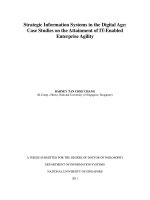Fundamental studies on wheel wear in ELID grinding
Bạn đang xem bản rút gọn của tài liệu. Xem và tải ngay bản đầy đủ của tài liệu tại đây (4.33 MB, 175 trang )
FUNDAMENTAL STUDIES ON WHEEL WEAR
IN ELID GRINDING
INDRANEEL BISWAS
BME (HONS), MS
A THESIS SUBMITTED
FOR THE DEGREE OF DOCTOR OF PHILOSOPHY
DEPARTMENT OF MECHANICAL ENGINEERING
NATIONAL UNIVERSITY OF SINGAPORE
2009
To
My Family
A
A
C
C
K
K
N
N
O
O
W
W
L
L
E
E
D
D
G
G
E
E
M
M
E
E
N
N
T
T
I am grateful to my supervisor Assoc. Prof. A. Senthil Kumar for being a source of
encouragement in the face of all research predicaments. I also express gratitude
towards my supervisor Prof. M. Rahman for his advice to help me overcome hurdles.
Without their support and their confidence in my research, completion of the thesis
would be impossible.
I have heartfelt appreciation for Dr. Lim Han Seok whose praise for my research idea
provided hope and confidence. I have been helped on several occasions by NUS staff,
Mr. Neo Ken Son, Mr. Tan Choon Huat, Mr. Lee Chiang Soon, Mr. Nelson,
Mr. Wong Chian Loong, Mr. Lim Soon Cheing, Mr. Simon, Mr. Ho Yan Chee and
Mrs. Siew Fah, for which I am grateful to them.
I am grateful to my fellow research scholars at NUS, Tanveer, Ahsan, Pervej, Sharon,
Woon, Haiyan, Xue, Masheed, Sadiq, Poh Ching, Lingling, Shaun and Asma, who
have become valuable friends after sharing ups and downs of academic research.
I am not grateful to my friends, Manish, Arup, Mrinal, Satyaki, Meiling, Jinyun,
Santanu, Mrs. Priyasree Home and Shalini for being friends in need, because
expressing gratefulness towards them will make them shy.
I cannot be grateful to my Father, Mother, Brother, Sister-in-law, Neil and other
relatives without whose belief, love and support I would not be, let alone the thesis.
i
T
T
A
A
B
B
L
L
E
E
O
O
F
F
C
C
O
O
N
N
T
T
E
E
N
N
T
T
S
S
Acknowledgement 0
Table of Contents ii
Summary vii
List of Figures ix
List of Tables xv
Symbols and Abbreviations xvi
Symbols xvi
Abbreviations xx
Chapter 1 Introduction 1
1.1 Evolution of Abrasive Machining 1
1.2 Advances in Grinding Technology 2
1.3 Challenges in Wheel Dressing 4
1.4 Introduction to ELID Grinding 5
1.5 Arrangement of Thesis 6
Chapter 2 Literature Survey 8
2.1 Fundamentals of ELID Grinding 9
2.1.1 Basic Mechanism of ELID Grinding 9
2.1.2 Detailed Analysis of ELID Grinding Mechanism 10
ii
2.1.3 Theoretical Analysis 13
2.2 Types of ELID Grinding 14
2.3 ELID Grinding System and its Developments 16
2.3.1 Power Supply 16
2.3.2 Cathode 17
2.3.3 Machine 17
2.3.4 Grinding Wheel 17
2.3.5 Truing 18
2.3.6 Electrolyte 18
2.4 Applications of ELID 18
2.5 Discussion 22
2.6 Scope of Work 24
2.7 Objectives of the Thesis 25
Chapter 3 Experimental Setup and Procedures 27
3.1 Setup Equipment 27
3.1.1 NC Machine Tool 28
3.1.2 Dressing Power Supply 30
3.2 Procedure 30
3.2.1 Measurement of Electrolyte Impedance 30
3.2.2 Dressing Experiment 31
3.2.3 Grinding Experiments 32
iii
3.3 Summary 33
Chapter 4 Impedance Studies of Electrolyte 34
4.1 Introduction 34
4.2 Governing Principle of ELID 35
4.3 Impedance of Electrolyte 39
4.4 Variation of Resistance with Flow Parameters 42
4.5 Change in Resistance by Gas Generation 45
4.6 Conclusions 47
Chapter 5 Studies of Electrolytic Dressing 49
5.1 Introduction 49
5.2 Theory 50
5.2.1 Input and Output Variables 50
5.2.2 Governing Equations 51
5.3 Experimental Growth of Oxide Layer 56
5.4 Properties of Oxide Layer 57
5.5 Validity of Theory 61
5.6 Summary 63
Chapter 6 Experimental Analysis of Wheel Wear 65
6.1 Introduction 65
6.2 Experimental Results and Discussions 68
6.2.1 Mechanism of ELID Grinding 68
iv
6.2.2 Empirical Relations 70
6.2.3 Categorization of ELID Grinding 72
6.2.4 Relationships between Variables 76
6.2.5 Effect on Finished Surface 80
6.3 Brittle Mode Grinding 85
6.4 Concluding Remarks 86
Chapter 7 Semi-Empirical Model 88
7.1 Introduction 88
7.2 Electrochemical Formulations 89
7.2.1 Formulation of Oxide Erosion 91
7.2.2 Combination of Oxide Formation and Erosion 93
7.3 Solution for Brittle Mode Material Removal 93
7.4 Results and Discussions 96
7.5 Model Solution for Ductile Regime Grinding 100
7.6 Results and Discussions 101
7.7 Concluding Remarks 105
Chapter 8 Analytical Model 107
8.1 Introduction 107
8.2 Geometry of Asperity 109
8.3 Oxide Wear from Grinding Chips 110
8.4 Electrolytic Dressing 113
v
vi
8.5 Solution of Equations 113
8.6 Concluding Remarks 118
Chapter 9 Case Studies 120
9.1 Continuous ELID Grinding 120
9.2 ELID Grinding with Idle Passes 123
9.3 Profile Estimation 123
9.4 Discussions 128
9.5 Concluding Remarks 129
Chapter 10 Conclusions, Contributions and Future Work 131
10.1 Conclusions 131
10.1.1 Studies on Impedance of Electrolyte 131
10.1.2 Investigations on Electrolytic Dressing 132
10.1.3 Experimental Study of Wheel Wear 133
10.1.4 ELID Grinding Models 134
10.2 Contributions 136
10.3 Future Work 137
Bibliography 139
Publications 151
S
S
U
U
M
M
M
M
A
A
R
R
Y
Y
Metal bonded superabrasive grinding wheels are extensively used for machining and
finishing hard and brittle materials, like mono-crystalline silicon, BK7 glass, silicon
nitride, PVD hard coatings, etc, used in the electronics, optical, aerospace, nuclear and
automobile industries. Electrolytic In-process Dressing (ELID) is perhaps the most
popular technique for conditioning such wheels.
In ELID, electrolysis forms soft and brittle anodic oxide of the metal bond of the
grinding wheel. This oxide is eroded off during grinding action, exposing new sharp
abrasives and shedding off old worn ones, along with grinding chips. The mechanism
of wheel wear in ELID is essentially through dissolution of the metal bond and
investigation of the underlying electrochemical phenomenon is the key to wheel wear
predictions. This is the basic approach of the thesis, which has not been the
concentration of previous researchers.
The electrolytic dressing process sets aside ELID grinding from conventional grinding.
Role of the electrolyte in the dressing process is first investigated. Other than
electrolyte, the dressing process is also characterized by electrolytic current and
thickness of anodic oxide layer. Fundamental behavior of the overall dressing process
is investigated to understand the relationship of dressing conditions with oxide layer
and electrolytic current and the process is modeled.
The combined effect of mechanical and electrolytic action during ELID grinding is
then investigated by parametric study of wheel wear in ductile regime grinding. The
process showed initial and steady stages of operation. The steady stage has cyclic
vii
viii
variations of grinding force and dressing current within specific limits such that the
average value per cycle is constant. It is found that wheel wear rate in steady stage has
a linear trend with a benchmark function defined from machining and dressing
conditions.
Brittle mode grinding experiments with coarse abrasives are carried out to find that its
steady stage of grinding does not have cyclic variations of force and current, but
retains a stable value. This is because the rates of oxide erosion and formation reach
equilibrium and maintains a stable layer thickness of oxide. Combination of the
dressing theory and an oxide erosion model is used to simulate the
dressing/electrolytic current which agrees with the experimental values.
Finally, an analytical and an empirical model for oxide erosion in ductile regime
grinding are developed. Each of these is combined with the dressing model to
simulate values of wheel wear rate and dressing current. The simulated values for
steady phase of grinding agree with the experimental values. The models are verified
with different types of experiments and are successful in predicting the profile of the
ground component by compensating wheel wear.
L
L
I
I
S
S
T
T
O
O
F
F
F
F
I
I
G
G
U
U
R
R
E
E
S
S
Figure 2.1: Schematic of ELID Grinding process 9
Figure 2.2: Mechanism of ELID Grinding 10
Figure 2.3: Brittle to ductile transition for BK7 glass for varying current duty cycle
[30] 12
Figure 2.4: Brittle to ductile transition for BK7 glass for different grit sizes [30] 12
Figure 2.5: Schematic of internal grinding with ELID-II [39] 14
Figure 2.6: Schematic of internal grinding with ELID-III [39] 15
Figure 2.7: Schematic diagram of ELID-IIIA [38] (a) ELID-3 machining system with
alternating current. (b) ELID without electrode. (c) Electrolysis of workpiece 15
Figure 2.8: Developed ELID machines at NUS [47] 17
Figure 2.9: ED-truing scheme [39] 18
Figure 2.10: Mirror surface generation on Si wafer [30] 19
Figure 3.1: Complete experimental setup with machine tool and sensor
instrumentation 27
Figure 3.2: Close-up photographs of the grinding scheme with sensor and fixture
accessories 28
Figure 3.3: Locus of grinding wheel traverse along the BK7 glass blank for wheel
wear experiments 33
Figure 4.1: Resistance for changing input peak voltages 39
ix
Figure 4.2: Voltage and current wave forms for resistive load of 33 Ω for (a) 10-10
µsec (b) 20-20 µsec pulse types 39
Figure 4.3: Voltage and current wave forms for electrolytic load 40
Figure 4.4: Voltage and current wave forms for dressing conditions (a) V
0
=100V,
T
ON
=10 µsec, T
OFF
=10 µsec, (b) V
0
=70V, T
ON
=20 µsec, T
OFF
=5 µsec 41
Figure 4.5: Voltage and current wave forms for 50% duty ratio and 10 µ
sec cycle time
41
Figure 4.6: Simplified model for electrolyte flow within electrode 42
Figure 4.7: Change of electrolyte resistance with electrode gap, grinding speeds and
flow rate 43
Figure 4.8: Velocity profile of electrolyte flow within the middle plane (z = 0.0015) of
inter-electrode gap in the (a) x-direction and (b) y-direction respectively 44
Figure 4.9: Average velocity of electrolyte for different electrode gaps and grinding
speeds 45
Figure 4.10: Comparison of resistivity with and without gas generation for resistance
for grinding wheel speed of 7.9 m
/sec and flow rate of 8 lpm 46
Figure 5.1: Representation of electrolytic dressing system
as an electrical circuit 52
Figure 5.2: Schematic showing oxide forms by consuming bond metal and grows in
the direction of the gap as well as the bond metal 53
Figure 5.3: Solution of the equations to obtain (a) wheel growth and (b) dressing
current for
η
=25%, c=40,
ρ
=1000
Ω
-cm, R
e
=9.5
Ω
56
x
Figure 5.4: Experimentally obtained characteristics of (a) oxide layer formation,
(b) dressing current, (c) dressing charge, and (d) ratio of wheel growth to dressing
charge 57
Figure 5.5: Stages of oxide formation on the grinding wheel surface (#325, square
pulse, 100V, CG7 electrolyte) 58
Figure 5.6: Electrolytic dressing carried out in static condition to investigate the
fundamental nature of oxide formation 58
Figure 5.7: (a) Oxide layer formation and (b) dressing current characteristics for
various dressing conditions 59
Figure 5.8: Microscopic image of #1200 wheel topography, with oxide layer scrapped
off, at 1000x showing surface undulations and abrasives 60
Figure 5.9: Comparison of the simulated values of (a) wheel growth and (b) dressing
current with experimental values 62
Figure 5.10: Comparison of #325 grinding wheel surface during the first minute of
pre-dressing and during in-process dressing 63
Figure 6.1: Grinding characteristics (a) norm
al and tangential forces, (b) dressing
current, (c) wheel wear, (d) k-value 67
Figure 6.2: Plot of wheel wear rate (WWR) vs material rem
oval rate (MRR) 70
Figure 6.3: Matrix of duty ratio vs MWF (mechanical wear factor) 72
Figure 6.4: Grinding characteristics for experiment with low MRR 73
Figure 6.5: Grinding characteristics of experim
ents with high MRR 74
Figure 6.6: Macroscopic view of #1200 grit size grinding wheel surface imm
ediately
after steady state grinding insufficient dressing 75
xi
Figure 6.7: Plot of ratio of WWR to vs Electrochemical Wear Factor (EWF) for
Sufficiently Dressed Conditions (SDC) 77
ec
L
Figure 6.8a: WWR vs Electrochemical wear factor for all experiments 78
Figure 6.9: Dressing current vs Electrochemical Wear Factor (SDC) 80
Figure 6.10: Surfaces generated during steady and initial stages of ELID grinding
(x1000) with S = 9.8 m/sec, f
r
= 320 mm/min, d
c
= 3 µ, MWF = 0.004756 units, EWF
= 0.003567 units, d
r
= 75% (a) during steady stage of grinding (Ra 11.5 nm),
(b) during initial stage of grinding (Ra 14.7 nm) 81
Figure 6.11: Variation of surface roughness (Ra value in nm) with MWF 81
Figure 6.12: Microphotograph of ground surfaces under 1500x magnification for
different grinding and dressing conditions 82
Figure 6.13: Grinding scheme incorporating idle strokes 83
Figure 6.14: Comparison of surface produced by grinding with and without idle pass
84
Figure 6.15: Force and current characteristics for grinding BK7 glass blanks with
#325 wheel 85
Figure 6.16: Microscopic image of BK7 glass surface ground with #325 wheel
showing material removal by brittle fractures 86
Figure 7.1: Variation of wear and current efficiency with oxide layer thickness 90
Figure 7.2: Profile of pre-dressed #325 wheel surface measured with touch probe after
scrapping off the oxide layer 94
xii
Figure 7.3: Comparison of simulation and experimental current development during
coarse grinding 96
Figure 7.4: Comparison of theoretical and experimental steady state current during
brittle mode grinding with #325 grit size 97
Figure 7.5: Simulated values of wheel wear of oxide and metal surfaces during coarse
grinding 98
Figure 7.6: Simulation values for change in current characteristics when there is a
small increase or decrease in the steady state wear rates 99
Figure 7.7: Profile of pre-dressed #1200 wheel surface m
easured with touch probe
after scrapping off the oxide layer 101
Figure 7.8: Comparison between experimental and simulation results of steady state
current and wheel wear rate for different ELID grinding conditions for mirror finish
of BK7 glass with #1200 wheel 102
Figure 7.9: Comparison of simulation and theoretical wheel wear during steady
grinding for
S=5.9 m/sec, f
r
=640 mm/min, d
c
=2µ, d
r
=50% 3) 103
Figure 7.10: Comparison of simulation and theoretical wheel wear during steady
grinding for
S=5.9 m/sec, f
r
=480 mm/min, d
c
=3µ, d
r
=90% 103
Figure 7.11: Wheel wear obtained from experimental dressing current compared with
directly measured wheel wear for S=5.9m/sec, f
r
=320 mm/min, d
c
=3µ, d
r
=75% 104
Figure 7.12: Wheel wear obtained from experimental dressing current compared with
directly measured wheel wear for
S=5.9m/sec, f
r
=480 mm/min, d
c
=3µ, d
r
=90% 105
Figure 8.1: Representation of asperity on grinding wheel 109
Figure 8.2: Asperity geometry 110
xiii
Figure 8.3: Schematic of asperity with adjacent oxide in 3D 111
Figure 8.4: Schematic of asperity with adjacent oxide in 2D during erosion 111
Figure 8.5: Algorithm for solution of analytical model 116
Figure 8.6: Variation of simulated WWR with time, for different h
0
and λ
0
values, for
igure 9.5: Achieved and estimated depth of material removal for given depth 127
n of different asperity shapes with adjacent oxide layer 129
parabolic asperity shape with d
c
=3 µ, S=7.9 m/s, f
r
=640 mm/min, d
r
=75%, V
0
=100V
116
Figure 8.7: Comparison of dressing
current for different asperity shapes for d
c
=3 µ,
S=7.9 m/s, f
r
=500 mm/min, d
r
=50%, 117
Figure 8.8: Comparison of volume of oxide eroded per rotation of wheel from
different volumes of existing oxide layer for the same MRPR 118
Figure 9.1: Comparison of experimental steady stage WWR for continuous grinding
experiments with the simulated values from the different models 121
Figure 9.2: Comparison of experimental steady stage dressing current for continuous
grinding experiments with the simulated values from the different models 122
Figure 9.3: Comparison of experimental wheel wear rate for grinding incorporating
idle pa
sses, with the simulated values from the different models 123
Figure 9.4: Schematic depicting the influence of wheel wear on ground profile 124
F
Figure 9.6: Cross-sectio
xiv
xv
L
L
IST OF
T
T
ABLES
IST OF ABLES
Table 3.1: Axis specifications of the NC machine 29
Table 6.1: Comparison of surface finish for ELID grinding with and without idle pass
84
Table 8.1: Relations for different asperity geometries 114
Table 9.1: Calculation of estimated depth-of-cut with semi-empirical model 126
Table 9.2: Calculation of estimated depth-of-cut with analytical model with conical
asperity shape 126
Table 9.3: Calculation of estimated depth-of-cut with analytical model with spherical
asperity shape 127
Table 9.4: Calculation of estimated depth-of-cut with analytical model with parabolic
asperity shape 127
S
S
Y
Y
M
M
B
B
O
O
L
L
S
S
A
A
N
N
D
D
A
A
B
B
B
B
R
R
E
E
V
V
I
I
A
A
T
T
I
I
O
O
N
N
S
S
Symbols
c ratio of oxide volume to oxide minus metal volume
d
c
depth-of-cut (µ)
d
r
current duty ratio
f
r
feed rate (mm/min)
f
l
flow rate of electrolyte (lt/min)
h ordinate of control asperity
h
0
maximum height of control asperity
h
ox
height of oxide from base of asperity
h
v
thickness of oxide displaced by grinding chips
i, i+1 used as subscript for denoting rotation number
i current density
i
0
exchange current density
k
o
0.044 carat of abrasive per cm
3
of bond
k
x
empirical constant for determining oxide erosion rate
k
vg
volume of hydrogen generated per unit charge
xvi
l
c
erosion of oxide layer per rotation of wheel representing wheel wear rate (µ)
l
c0
initial value of mechanical wheel wear per rotation (µ)
l
e
increase in layer thickness due to oxide formation per rotation of wheel (µ)
l
t
wear due to pitting (µ)
m
r
material removed per rotation of wheel
p concentration specification of grinding wheel
s
a
density of abrasive (gm/cc)
s
m
density of metal bond (gm/cc)
s
o
density of metal oxide (gm/cc)
t time (sec)
t
i
pulse increase time (µsec)
t
d
pulse decrease time (µsec)
t
e
time of electrolysis per unit rotation of wheel (sec)
w
r
wheel wear rate
z valency of metal bond
Ac cross-section area of asperity
A
e
cathode area (cm
2
)
A
f
area of new surface created by crack propagation
C
PBR
PBR ratio
E
a
electrode potential for the anode (V)
E
c
electrode potential for the cathode (V)
xvii
E
f
energy for fracture
F Faraday’s constant (CGS units)
F
n
normal component of grinding force (N)
F
t
tangential component of grinding force (N)
G Griffith Crack Propagation parameter
I dressing current (amp)
I
avg
average current
L oxide layer thickness (µ)
L
a
increase in wheel radius due to oxide formation (aka oxide growth)
ec
L
rate of oxide formation obtained theoretically from electrochemistry
L
g
inter-electrode gap (cm)
L
1
maximum thickness of stable oxide during coarse grinding (µ)
L
2
minimum thickness of stable oxide during coarse grinding (µ)
ec
L
hypothetical wheel wear rate
L
s
steady state thickness of oxide layer (µ)
L
t
minimum layer thickness beyond which pitting is initiated (µ)
2
L thickness of oxide layer corresponding to minimum current efficiency (µ)
M, M
m
molecular weight of metal bond
M
o
molecular weight of anodic oxide
R Gas constant
xviii
R
e
resistance of electrolyte (Ω)
S grinding wheel speed (rpm)
S
o
grinding wheel speed (m/sec)
T temperature in absolute scale (K)
T
0
total time of dressing (sec)
T
ON
ON time of voltage pulse
T
OFF
OFF time of voltage pulse
V voltage function (V)
V
asp
volume of the asperity from peak upto height h
V
0
peak voltage (V)
V Ohmic potential drop
g
V
volumetric gas generation rate
V
m
volume of metal bond (cc)
V
ox
volume of anodic oxide (cc)
V
r
resistance overpotential
V
t
total volume of bond and abrasive
V
v
volume of grinding chips generated by control area per rotation of wheel
α fraction of overpotential associated with metal dissolution
β and the volume proportion of gas in electrolyte
δ increase/decrease of mechanical wheel wear rate per rotation
η current efficiency (%)
xix
1
maximum current efficiency (%)
2
minimum current efficiency (%)
a
activation overpotential
conc
concentration overpotential
η
H
current efficiency for hydrogen generation
λ abscissa of control asperity (µ)
λ
0
base diameter of control asperity (µ)
ρ resistivity of anodic oxide (Ω-cm)
ρ
e
resistivity of electrolyte (Ω-cm)
ρ
g
resistivity of electrolyte with gas generation
Abbreviations
CIB cast iron bond
ECD electro-chemical deposition
ECM electro-chemical machining
ED electro-discharge
EDM electro-discharge machining
ELID electrolytic in-process dressing
EWF ELID wear factor
MR material removal
MRPR material removal per rotation
xx
xxi
MRR material removal rate
MWF mechanical wear factor
PBR Pilling Bedworth Ratio
SD synthetic diamond
SDC sufficiently dressed condition
UDC under- dressed condition
WWR wheel wear rate
Chapter
1
I
Chapter 1
I
NTRODUCTION
NTRODUCTION
1.1 Evolution of Abrasive Machining
The fundamental Abrasive Machining process has been in existence since the Stone
Age with man rubbing stones against each other to produce sharp weapons. The
Egyptians have been known to polish jewelry and vases. Chinese texts of the 13
th
Century document the use of seashell glued on parchment with natural gums, and
used for polishing purposes. In the 15
th
Century, the Swiss have been known to use
crushed glass on paper substrate as emery paper [1]. The first historical record of
rotary grinding stone has been depicted in drawings in the 1
st
Century AD, and later in
the drawings of Leonardo da Vinci [2]. Finally, the modern grinding machines were
invented in the first half of the 19
th
Century for finishing clock parts [2]. Further
industrialization led to the development of abrasive machining processes into the
categories of honing, lapping, polishing and grinding, for achieving desired levels of
surface finish and integrity.
The most popular abrasives used for these processes are silicon carbide (SiC) and
aluminum oxide (alumina). SiC and alumina, historically known as corborundum and
alundum respectively, were invented in the 1890s and have hardness of approximately
24 and 21 GPa respectively [3]. Till date, these grades of grinding wheels represent
approximately half of conventional grinding and are used for a wide range of mass
produced precision components [3].
1
Advancement of grinding technology took a leap unlike its initial slow paced
evolution. The first computers like Z3, Atanasoff–Berry Computer (ABC), Electronic
Numerical Integrator And Computer (ENIAC) were completed in the 1940s and
marked the beginning of the Information Age. Integrated circuit (IC), invented in
1958, initiated the electronics industry which is still growing and Moore’s Law states
this growth in electronics performance to be approximately doubled every two years.
The boost in the electronics industry has accompanied with a rapid progress in
automobile, aerospace, optical, nuclear, communication and relevant industries. New
fields of engineering like mechatronics, bio-engineering, MEMS and nano-technology
have been founded as a result of this advancement, and have produced the need for
advanced materials. Development of electronics has also introduced miniaturization.
Since the natural resources are limited, miniaturized products cater to the increasing
population and maintain the exponential industrial growth. Increase in performance
and miniaturization has been made possible through the use of innovative and
advanced materials with excellent physical properties. So, hard and brittle, difficult-
to-cut materials like optical glasses, cemented carbides, PVD hard coatings, single
crystal materials (like silicon), advanced ceramic materials (like alumina, silicon
nitride, silicon carbide and zirconia), due to their advanced mechanical, chemical and
electrical properties, have become popular choice of the industries. However, the
enhanced properties which make the materials suitable for the industries also
challenge the existing manufacturing engineering and innovation.
1.2 Advances in Grinding Technology
Grinding technology kept pace with these increasing demands of the new age
materials and had to evolve from the use of conventional SiC and alumina abrasives.
2
